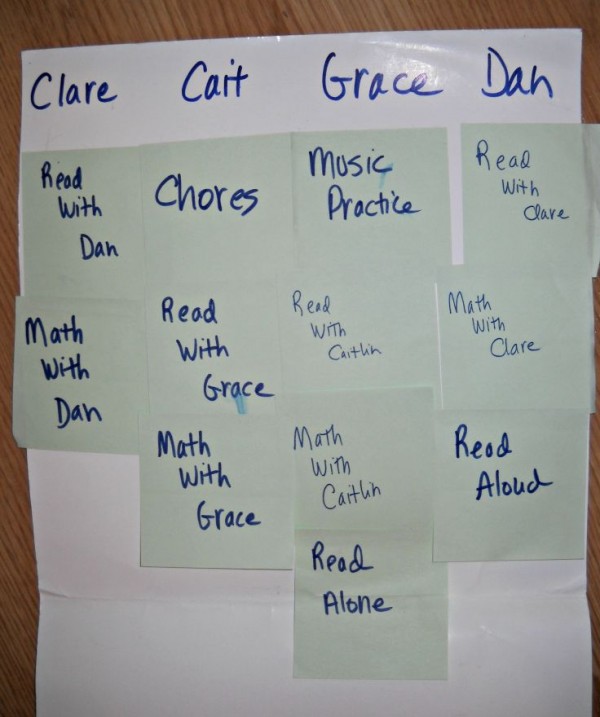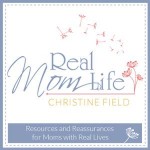How to Teach Multiple Ages in Your Homeschool
A Mom wrote asking for help in dividing time between teaching 3 children without “teaching” all day long. She is also homeschooling one with special needs and having time to devote extra time to him is challenging.
Help! There are no easy answers to teaching a number of children of different ages in your home school. Add in a child who needs extra one-on-one and mom can easily feel overwhelmed.
There is no question that Mom needs to be organized and the children need to know what is expected of them. If you are a go-with-the-flow kind of mom, this may challenge you but try it and see if you don’t feel less overwhelmed.
One big de-stressor is to study the same subject area for content subjects like Bible, Science and Math. You can work on the same topic, but have varying expectations based on the kids levels and abilities. This type of multi-age teaching is addressed in many modern curriculum publishers, like The Story of the World or The Mystery of History.

Physical set-up
Develop a system of taking turns with each of your children. You can work with each child a few minutes at a time while the others do individual work. Here are some ideas to help that to happen:
- Organize your physical space so you can move easily from child to child. One mom arranged three desks in a sort of triangle allowing her to move quickly from one child to the next inside of it.
- Make sure your children know what they are to do while they are waiting for Mom. You might consider posting a chart like this that reads:
While waiting for Mom, I may:
- Move on to another problem in my current assignment
- Read a book for a book report or school project
- Do work for another subject.
Remind your children (and yourself!) that in a traditional school classroom, they would be competing with thirty other kids, instead of just two, three, or four, for the attention of their teacher. >Other Systems Encourage independence from an early age. Even very young children can play alone for a time. Give them the tools they need to work alone. Go slowly, first giving five minutes to work without you, then gradually increasing that time. Do you have a child who can’t seem to work unless you are sitting by their side? Try even thirty seconds working alone, and then gradually increase that amount.
Set up a system of accountability.
Having assignment sheets and checklists made up for every child can help ensure that independent work is completed on a daily and/or weekly basis. Spend time together in the morning on prayer, individual instruction and introduction of new material; then dismiss your children to work on their independent assignments.
Allow them some choice in how they approach their assignments. Some may choose to do the hardest subjects first, then the easier ones. Some may do a week’s worth of work in one subject in a single day, and then work on a different subject the next day.
When they need more of Mom
Teaching multiple ages is multiplied in difficulty when mom needs to spend significant extra time with one child, either due to home therapies or just the added attention they need. A child with learning differences needs a balance of remediation activities and therapies.
Together that spells TIME CONSUMING for Mom.
Although most days may not feel this way, but there is strength in numbers! Mom’s challenge is to organize that strength.
This involves detailed scheduling and recruiting older kids to help younger kids. Here’s what I mean by that:
- There are things that children can do alone
- An older child can always read with or to a younger child
- An older child can help a younger child with math
- An older child can stand by or monitor when a special needs child does computer drills or remedial work
Often, these things need to be suggested, encouraged and nurtured. Here’s how one mom started to put all the pieces together to make things work.
She wrote all the tasks/subjects for/with each child that needed to be done on Post It Notes. Next came the fun part. Making a chart with columns for each child, she shuffled the Posit Notes to arrange the day for each child in a way that made sense.
When placing the tasks, she took into consideration who could work with whom and what would be done with only Mom. If the first arrangement didn’t work well, she rearranged it until it was a workable solution.

Here is a photo of what emerged: Notice that the chart takes into account things that child can do alone, like chores and music practice; things that children can do together, like reading together; and things that each child needs mom to do.
By devoting some time and thought to who does what when, you may find it much easier to meet the needs of multiple children and maintain a semblance of order in your home.
The schedule doesn’t have to be rigid or inflexible, but it will give you a track on which to run your day. Get a poster board and some sticky notes and give it a try! For more information on how to Manage Multiple-Ages in the Homeschool, take a look at this book by Christine Field.


I’m a deeply flawed, Christian mom, author, speaker, attorney, and listener with a rich variety of life experiences. I advocate and champion mothers and family life. I help weary, discouraged moms find solutions for unexpected family challenges so they can know peace, joy (and a little bit of fun!) in the divine calling of mothering. Maybe you can relate to my non-Pin-worthy life. If I can ever serve or encourage you, please find me on Facebook, Twitter or Pinterest.



Great tips! I certainly have a variety of ages and abilities. Going to try some of these!
Great advice…thanks! I pinned it. 🙂
I like all of the ideas listed! 🙂